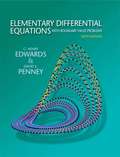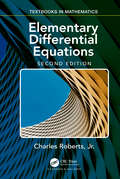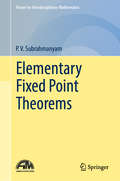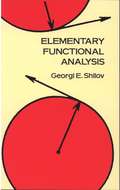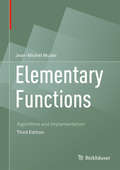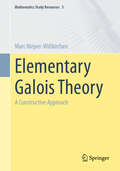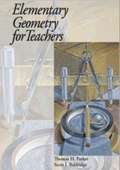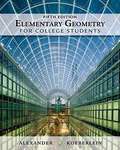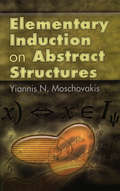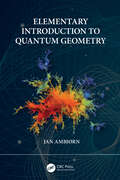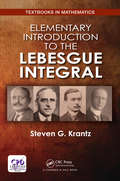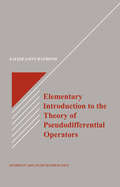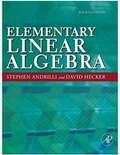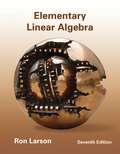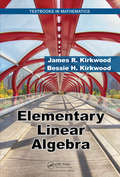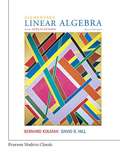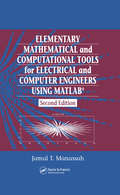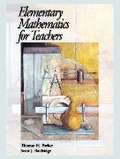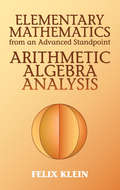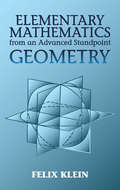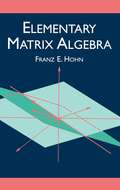- Table View
- List View
Elementary Differential Equations With Boundary Value Problems
by Howard Anton William TrenchWritten in a clear and accurate language that students can understand, Trench's new book minimizes the number of explicitly stated theorems and definitions. Instead, he deals with concepts in a conversational style that engages students. He includes more than 250 illustrated, worked examples for easy reading and comprehension. One of the book's many strengths is its problems, which are of consistently high quality. Trench includes a thorough treatment of boundary-value problems and partial differential equations and has organized the book to allow instructors to select the level of technology desired. This has been simplified by using symbols, C and L, to designate the level of technology. C problems call for computations and/or graphics, while L problems are laboratory exercises that require extensive use of technology. Informal advice on the use of technology is included in several sections and instructors who prefer not to emphasize technology can ignore these exercises without interrupting the flow of material.
Elementary Differential Equations with Boundary Value Problems (Sixth Edition)
by David E. Penney C. Henry EdwardsThe Sixth Edition of this widely adopted book remains the same classic differential equations text it's always been, but has been polished and sharpened to serve both instructors and students even more effectively.Edwards and Penney teach students to first solve those differential equations that have the most frequent and interesting applications. Precise and clear-cut statements of fundamental existence and uniqueness theorems allow understanding of their role in this subject. A strong numerical approach emphasizes that the effective and reliable use of numerical methods often requires preliminary analysis using standard elementary techniques.
Elementary Differential Equations: Applications, Models, and Computing (Textbooks in Mathematics)
by Charles Roberts Jr.<p>Elementary Differential Equations, Second Edition is written with the knowledge that there has been a dramatic change in the past century in how solutions to differential equations are calculated. However, the way the topic has been taught in introductory courses has barely changed to reflect these advances, which leaves students at a disadvantage. This second edition has been created to address these changes and help instructors facilitate new teaching methods and the latest tools, which includes computers. <p>The text is designed to help instructors who want to use computers in their classrooms. It accomplishes this by emphasizing and integrating computers in teaching elementary or ordinary differential equations. Many examples and exercises included in the text require the use of computer software to solve problems. It should be noted that since instructors use their own preferred software, this book has been written to be independent of any specific software package. <p>Features: <p> <li>Focuses on numerical methods and computing to generate solutions <li>Features extensive coverage of nonlinear differential equations and nonlinear systems <li>Includes software programs to solve problems in the text which are located on the author's website <li>Contains a wider variety of non-mathematical models than any competing textbook</li> <p>This second edition is a valuable, up-to-date tool for instructors teaching courses about differential equations. It serves as an excellent introductory textbook for undergraduate students majoring in applied mathematics, computer science, various engineering disciplines and other sciences. They also will find that the textbook will aide them greatly in their professional careers because of its instructions on how to use computers to solve equations.</p>
Elementary Fixed Point Theorems (Forum for Interdisciplinary Mathematics)
by P. V. SubrahmanyamThis book provides a primary resource in basic fixed-point theorems due to Banach, Brouwer, Schauder and Tarski and their applications. Key topics covered include Sharkovsky’s theorem on periodic points, Thron’s results on the convergence of certain real iterates, Shield’s common fixed theorem for a commuting family of analytic functions and Bergweiler’s existence theorem on fixed points of the composition of certain meromorphic functions with transcendental entire functions. Generalizations of Tarski’s theorem by Merrifield and Stein and Abian’s proof of the equivalence of Bourbaki–Zermelo fixed-point theorem and the Axiom of Choice are described in the setting of posets. A detailed treatment of Ward’s theory of partially ordered topological spaces culminates in Sherrer fixed-point theorem. It elaborates Manka’s proof of the fixed-point property of arcwise connected hereditarily unicoherent continua, based on the connection he observed between set theory and fixed-point theory via a certain partial order. Contraction principle is provided with two proofs: one due to Palais and the other due to Barranga. Applications of the contraction principle include the proofs of algebraic Weierstrass preparation theorem, a Cauchy–Kowalevsky theorem for partial differential equations and the central limit theorem. It also provides a proof of the converse of the contraction principle due to Jachymski, a proof of fixed point theorem for continuous generalized contractions, a proof of Browder–Gohde–Kirk fixed point theorem, a proof of Stalling's generalization of Brouwer's theorem, examine Caristi's fixed point theorem, and highlights Kakutani's theorems on common fixed points and their applications.
Elementary Functional Analysis
by Georgi E. ShilovIn this introductory work on mathematical analysis, the noted mathematician Georgi E. Shilov begins with an extensive and important chapter on the basic structures of mathematical analysis: linear spaces, metric spaces, normed linear spaces, Hilbert spaces, and normed algebras. The standard models for all these spaces are sets of functions (hence the term "functional analysis"), rather than sets of points in a finite-dimensional space.Chapter 2 is devoted to differential equations, and contains the basic theorems on existence and uniqueness of solutions of ordinary differential equations for functions taking values in a Banach space. The solution of the linear equation with constant (operator) coefficients is written in general form in terms of the exponential of the operator. This leads, in the finite-dimensional case, to explicit formulas not only for the solutions of first-order equations, but also to the solutions of higher-order equations and systems of equations. The third chapter presents a theory of curvature for curve in a multidimensional space.The final two chapters essentially comprise an introduction to Fourier analysis. In the treatment of orthogonal expansions, a key role is played by Fourier series and the various kinds of convergence and summability for such series. The material on Fourier transforms, in addition to presenting the more familiar theory, also deals with problems in the complex domain, in particular with problems involving the Laplace transform.Designed for students at the upper-undergraduate or graduate level, the text includes a set of problems for each chapter, with hints and answers at the end of the book.
Elementary Functions
by Jean-Michel MullerThis textbook presents the concepts and tools necessary to understand, build, and implement algorithms for computing elementary functions (e. g. , logarithms, exponentials, and the trigonometric functions). Both hardware- and software-oriented algorithms are included, along with issues related to accurate floating-point implementation. This third edition has been updated and expanded to incorporate the most recent advances in the field, new elementary function algorithms, and function software. After a preliminary chapter that briefly introduces some fundamental concepts of computer arithmetic, such as floating-point arithmetic and redundant number systems, the text is divided into three main parts. Part I considers the computation of elementary functions using algorithms based on polynomial or rational approximations and using table-based methods; the final chapter in this section deals with basic principles of multiple-precision arithmetic. Part II is devoted to a presentation of "shift-and-add" algorithms (hardware-oriented algorithms that use additions and shifts only). Issues related to accuracy, including range reduction, preservation of monotonicity, and correct rounding, as well as some examples of implementation are explored in Part III. Numerous examples of command lines and full programs are provided throughout for various software packages, including Maple, Sollya, and Gappa. New to this edition are an in-depth overview of the IEEE-754-2008 standard for floating-point arithmetic; a section on using double- and triple-word numbers; a presentation of new tools for designing accurate function software; and a section on the Toom-Cook family of multiplication algorithms. The techniques presented in this book will be of interest to implementers of elementary function libraries or circuits and programmers of numerical applications. Additionally, graduate and advanced undergraduate students, professionals, and researchers in scientific computing, numerical analysis, software engineering, and computer engineering will find this a useful reference and resource. PRAISE FOR PREVIOUS EDITIONS "[T]his book seems like an essential reference for the experts (which I'm not). More importantly, this is an interesting book for the curious (which I am). In this case, you'll probably learn many interesting things from this book. If you teach numerical analysis or approximation theory, then this book will give you some good examples to discuss in class. " -- MAA Reviews (Review of Second Edition) "The rich content of ideas sketched or presented in some detail in this book is supplemented by a list of over three hundred references, most of them of 1980 or more recent. The book also contains some relevant typical programs. " -- Zentralblatt MATH (Review of Second Edition) "I think that the book will be very valuable to students both in numerical analysis and in computer science. I found [it to be] well written and containing much interesting material, most of the time disseminated in specialized papers published in specialized journals difficult to find. " -- Numerical Algorithms (Review of First Edition)
Elementary Galois Theory: A Constructive Approach (Mathematics Study Resources #3)
by Marc Nieper-WißkirchenWhy is the squaring of the circle, why is the division of angles with compass and ruler impossible? Why are there general solution formulas for polynomial equations of degree 2, 3 and 4, but not for degree 5 or higher? This textbook deals with such classical questions in an elementary way in the context of Galois theory. It thus provides a classical introduction and at the same time deals with applications. The point of view of a constructive mathematician is consistently adopted: To prove the existence of a mathematical object, an algorithmic construction of that object is always given. Some statements are therefore formulated somewhat more cautiously than is classically customary; some proofs are more elaborately conducted, but are clearer and more comprehensible. Abstract theories and definitions are derived from concrete problems and solutions and can thus be better understood and appreciated. The material in this volume can be covered in a one-semester lecture on algebra right at the beginning of mathematics studies and is equally suitable for first-year students at the Bachelor's level and for teachers. The central statements are already summarised and concisely presented within the text, so the reader is encouraged to pause and reflect and can repeat content in a targeted manner. In addition, there is a short summary at the end of each chapter, with which the essential arguments can be comprehended step by step, as well as numerous exercises with an increasing degree of difficulty. The translation was done with the help of artificial intelligence. A subsequent human revision was done primarily in terms of content.
Elementary Geometry For Teachers
by Thomas H. Parker Scott J. BaldridgeThis is a mathematics textbook for teachers that focuses on the parts of the K-8 curriculum involving measurement and geometry; it also includes a chapter on data, probability and statistics. It is a sequel to our text Elementary Mathematics for Teachers (EMT), which focused on arithmetic.
Elementary Geometry for College Students
by Daniel C. Alexander Geralyn M. KoeberleinBuilding on the success of its first four editions, the Fifth Edition of this market-leading text covers the important principles and real-world applications of plane geometry, with a new chapter on locus and concurrence and by adding 150-200 new problems including 90 designed to be more rigorous. Strongly influenced by both NCTM and AMATYC standards, the text takes an inductive approach that includes integrated activities and tools to promote hands-on application and discovery.
Elementary Induction on Abstract Structures
by Yiannis N. MoschovakisHailed by the Bulletin of the American Mathematical Society as "easy to use and a pleasure to read," this research monograph is recommended for students and professionals interested in model theory and definability theory. The sole prerequisite is a familiarity with the basics of logic, model theory, and set theory.The author, Professor of Mathematics at UCLA and Emeritus Professor of Mathematics,University of Athens, Greece, begins with a focus on the theory of inductive and hyperelementary sets. Subsequent chapters advance to acceptable structures and countable acceptable structures, concluding with the main result of the Barwise-Gandy-Moschovakis theory, which is the key to many applications of abstract recursion theory. Exercises at the end of each chapter form an integral part of the text, offering examples useful to the development of the general theory and outlining the theory's extensions.
Elementary Introduction to Quantum Geometry
by Jan AmbjornThis graduate textbook provides an introduction to quantum gravity, when spacetime is two-dimensional. The quantization of gravity is the main missing piece of theoretical physics, but in two dimensions it can be done explicitly with elementary mathematical tools, but it still has most of the conceptional riddles present in higher dimensional (not yet known) quantum gravity. It provides an introduction to a very interdisciplinary field, uniting physics (quantum geometry) and mathematics (combinatorics) in a non-technical way, requiring no prior knowledge of quantum field theory or general relativity. Using the path integral, the chapters provide self-contained descriptions of random walks, random trees and random surfaces as statistical systems where the free relativistic particle, the relativistic bosonic string and two-dimensional quantum gravity are obtained as scaling limits at phase transition points of these statistical systems. The geometric nature of the theories allows one to perform the path integral by counting geometries. In this way the quantization of geometry becomes closely linked to the mathematical fields of combinatorics and probability theory. By counting the geometries, it is shown that the two-dimensional quantum world is fractal at all scales unless one imposes restrictions on the geometries. It is also discussed in simple terms how quantum geometry and quantum matter can interact strongly and change the properties both of the geometries and of the matter systems. It requires only basic undergraduate knowledge of classical mechanics, statistical mechanics and quantum mechanics, as well as some basic knowledge of mathematics at undergraduate level. It will be an ideal textbook for graduate students in theoretical and statistical physics and mathematics studying quantum gravity and quantum geometry. Key features: Presents the first elementary introduction to quantum geometry Explores how to understand quantum geometry without prior knowledge beyond bachelor level physics and mathematics. Contains exercises, problems and solutions to supplement and enhance learning
Elementary Introduction to the Lebesgue Integral (Textbooks in Mathematics)
by Steven G. KrantzIt is important and useful to have a text on the Lebesgue theory that is accessible to bright undergraduates. This is such a text. Going back to the days of Isaac Newton and Gottfried Wilhelm von Leibniz, and even to Newton's teacher Isaac Barrow, the integral has been a mainstay of mathematical analysis. The integral is a device for amalgamating information. It is a powerful and irreplaceable tool. The text concentrates on the real line. The student will be familiar with the real numbers and will be comfortable internalizing the new ideas of measure theory in that context. In addition to having copious examples and numerous figures, this book includes a Table of Notation and a Glossary.
Elementary Introduction to the Theory of Pseudodifferential Operators (Studies In Advanced Mathematics Ser. #3)
by Xavier Saint RaymondIn the 19th century, the Fourier transformation was introduced to study various problems of partial differential equations. Since 1960, this old tool has been developed into a well-organized theory called microlocal analysis that is based on the concept of the pseudo-differential operator. This book provides the fundamental knowledge non-specialists need in order to use microlocal analysis. It is strictly mathematical in the sense that it contains precise definitions, statements of theorems and complete proofs, and follows the usual method of pure mathematics. The book explains the origin of the theory (i.e., Fourier transformation), presents an elementary construcion of distribution theory, and features a careful exposition of standard pseudodifferential theory. Exercises, historical notes, and bibliographical references are included to round out this essential book for mathematics students; engineers, physicists, and mathematicians who use partial differential equations; and advanced mathematics instructors.
Elementary Linear Algebra
by David Hecker Stephen AndrilliElementary Linear Algebra develops and explains in careful detail the computational techniques and fundamental theoretical results central to a first course in linear algebra. This highly acclaimed text focuses on developing the abstract thinking essential for further mathematical study. <p><p>The authors give early, intensive attention to the skills necessary to make students comfortable with mathematical proofs. The text builds a gradual and smooth transition from computational results to general theory of abstract vector spaces. It also provides flexbile coverage of practical applications, exploring a comprehensive range of topics.
Elementary Linear Algebra
by Ron LarsonThe cornerstone of ELEMENTARY LINEAR ALGEBRA is the authors' clear, careful, and concise presentation of material--written so that readers can fully understand how mathematics works. This program balances theory with examples, applications, and geometric intuition for a complete, step-by-step learning system. Featuring a new design that highlights the relevance of the mathematics and improves readability, the Seventh Edition also incorporates new conceptual Capstone exercises that reinforce multiple concepts in each section. Data and applications reflect current statistics and examples to engage users and demonstrate the link between theory and practice.
Elementary Linear Algebra (Textbooks in Mathematics)
by James R. Kirkwood Bessie H. KirkwoodElementary Linear Algebra is written for the first undergraduate course. The book focuses on the importance of linear algebra in many disciplines such as engineering, economics, statistics, and computer science. The text reinforces critical ideas and lessons of traditional topics. More importantly, the book is written in a manner that deeply ingrains computational methods.
Elementary Linear Algebra With Applications
by David Hill Bernard KolmanThis text presents the basic ideas of linear algebra in a manner that offers students a fine balance between abstraction/theory and computational skills. The emphasis is on not just teaching how to read a proof but also on how to write a proof.
Elementary Mathematical and Computational Tools for Electrical and Computer Engineers Using MATLAB (Second Edition)
by Jamal T. Manassah<p>Engineers around the world depend on MATLAB for its power, usability, and outstanding graphics capabilities. Yet too often, engineering students are either left on their own to acquire the background they need to use MATLAB, or they must learn the program concurrently within an advanced course. Both of these options delay students from solving realistic design problems, especially when they do not have a text focused on applications relevant to their field and written at the appropriate level of mathematics. <p>Ideal for use as a short-course textbook and for self-study Elementary Mathematical and Computational Tools for Electrical and Computer Engineers Using MATLAB fills that gap. Accessible after just one semester of calculus, it introduces the many practical analytical and numerical tools that are essential to success both in future studies and in professional life. Sharply focused on the needs of the electrical and computer engineering communities, the text provides a wealth of relevant exercises and design problems. Changes in MATLAB's version 6.0 are included in a special addendum. <p>The lack of skills in fundamental quantitative tools can seriously impede progress in one's engineering studies or career. By working through this text, either in a lecture/lab environment or by themselves, readers will not only begin mastering MATLAB, but they will also hone their analytical and computational skills to a level that will help them to enjoy and succeed in subsequent electrical and computer engineering pursuits.</p>
Elementary Mathematics Curriculum Materials: Designs for Student Learning and Teacher Enactment (Research in Mathematics Education)
by Janine T. Remillard Ok-Kyeong KimThe book presents comparative analyses of five elementary mathematics curriculum programs used in the U.S. from three different perspectives: the mathematical emphasis, the pedagogical approaches, and how authors communicate with teachers. These perspectives comprise a framework for examining what curriculum materials are comprised of, what is involved in reading and interpreting them, and how curriculum authors can and do support teachers in this process. Although the focus of the analysis is 5 programs used at a particular point in time, this framework extends beyond these specific programs and illuminates the complexity of curriculum materials and their role in teaching in general. Our analysis of the mathematical emphasis considers how the mathematics content is presented in each program, in terms of sequencing, the nature of mathematical tasks (cognitive demand and ongoing practice), and the way representations are used. Our analysis of the pedagogical approach examines explicit and implicit messages about how students should interact with mathematics, one another, the teacher, and the textbook around these mathematical ideas, as well as the role of the teacher. In order to examine how curriculum authors support teachers, we analyze how they communicate with teachers and what they communicate about, including the underlying mathematics, noticing student thinking, and rationale for design elements. The volume includes a chapter on curriculum design decisions based on interviews with curriculum authors.
Elementary Mathematics for Teachers
by Thomas H. Parker Scott J. BaldridgeA mathematics course for elementary teachers.
Elementary Mathematics from an Advanced Standpoint: Arithmetic, Algebra, Analysis
by Felix Klein"Makes the reader feel the inspiration that comes from listening to a great mathematician." -- Bulletin, American Mathematical SocietyA distinguished mathematician and educator enlivens abstract discussions of arithmetic, algebra, and analysis by means of graphical and geometrically perceptive methods. His three-part treatment begins with topics associated with arithmetic, including calculating with natural numbers, the first extension of the notion of number, special properties of integers, and complex numbers. Algebra-related subjects constitute the second part, which examines real equations with real unknowns and equations in the field of complex quantities. The final part explores elements of analysis, with discussions of logarithmic and exponential functions, the goniometric functions, and infinitesimal calculus. 1932 edition. 125 figures.
Elementary Mathematics from an Advanced Standpoint: Geometry (Dover Books on Mathematics #2)
by Felix Klein"Nothing comparable to it." — Mathematics Teacher. This comprehensive three-part treatment begins with a consideration of the simplest geometric manifolds: line-segment, area, and volume as relative magnitudes; the Grassmann determinant principle for the plane and the Grassmann principle for space; classification of the elementary configurations of space according to their behavior under transformation of rectangular coordinates; and derivative manifolds. The second section, on geometric transformations, examines affine and projective transformations; higher point transformations; transformations with change of space element; and the theory of the imaginary. The text concludes with a systematic discussion of geometry and its foundations. 1939 edition. 141 figures.
Elementary Matrix Algebra (Dover Books on Mathematics)
by Franz E. HohnThis complete and coherent exposition, complemented by numerous illustrative examples, offers readers a text that can teach by itself. Fully rigorous in its treatment, it offers a mathematically sound sequencing of topics. The work starts with the most basic laws of matrix algebra and progresses to the sweep-out process for obtaining the complete solution of any given system of linear equations -- homogeneous or nonhomogeneous -- and the role of matrix algebra in the presentation of useful geometric ideas, techniques, and terminology.Other subjects include the complete treatment of the structure of the solution space of a system of linear equations, the most commonly used properties of determinants, and linear operators and linear transformations of coordinates. Considerably more material than can be offered in a one-semester course appears here; this comprehensive volume by Franz E. Hohn, Professor of Mathematics at the University of Illinois for many years, provides instructors with a wide range of choices in order to meet differing interests and to accommodate students with varying backgrounds.
Elementary Matrix Theory (Dover Books on Mathematics)
by Howard EvesThe usefulness of matrix theory as a tool in disciplines ranging from quantum mechanics to psychometrics is widely recognized, and courses in matrix theory are increasingly a standard part of the undergraduate curriculum.This outstanding text offers an unusual introduction to matrix theory at the undergraduate level. Unlike most texts dealing with the topic, which tend to remain on an abstract level, Dr. Eves' book employs a concrete elementary approach, avoiding abstraction until the final chapter. This practical method renders the text especially accessible to students of physics, engineering, business and the social sciences, as well as math majors. Although the treatment is fundamental -- no previous courses in abstract algebra are required -- it is also flexible: each chapter includes special material for advanced students interested in deeper study or application of the theory.The book begins with preliminary remarks that set the stage for the author's concrete approach to matrix theory and the consideration of matrices as hypercomplex numbers. Dr. Eves then goes on to cover fundamental concepts and operations, equivalence, determinants, matrices with polynomial elements, similarity and congruence. A final optional chapter considers matrix theory from a generalized or abstract viewpoint, extending it to arbitrary number rings and fields, vector spaces and linear transformations of vector spaces. The author's concluding remarks direct the interested student to possible avenues of further study in matrix theory, while an extensive bibliography rounds out the book.Students of matrix theory will especially appreciate the many excellent problems (solutions not provided) included in each chapter, which are not just routine calculation exercises, but involve proof and extension of the concepts and material of the text. Scientists, engineers, economists and others whose work involves this important area of mathematics, will welcome the variety of special types of matrices and determinants discussed, which make the book not only a comprehensive introduction to the field, but a valuable resource and reference work.
Elementary Mechanics Using Matlab
by Anders Malthe-SørenssenThis book - specifically developed as a novel textbook on elementary classical mechanics - shows how analytical and numerical methods can be seamlessly integrated to solve physics problems. This approach allows students to solve more advanced and applied problems at an earlier stage and equips them to deal with real-world examples well beyond the typical special cases treated in standard textbooks. Another advantage of this approach is that students are brought closer to the way physics is actually discovered and applied, as they are introduced right from the start to a more exploratory way of understanding phenomena and of developing their physical concepts. While not a requirement, it is advantageous for the reader to have some prior knowledge of scientific programming with a scripting-type language. This edition of the book uses Matlab, and a chapter devoted to the basics of scientific programming with Matlab is included. A parallel edition using Python instead of Matlab is also available. Last but not least, each chapter is accompanied by an extensive set of course-tested exercises and solutions.

